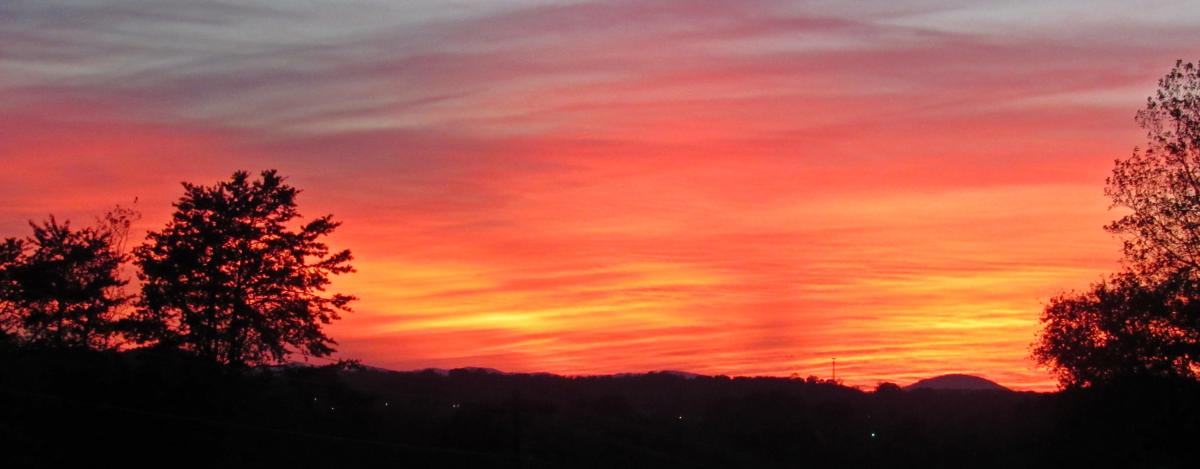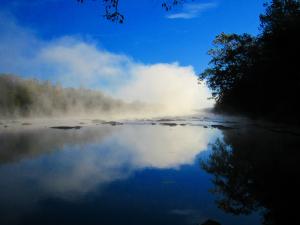 Like a lot of folks, Fall is my favorite time of year. I have been very fortunate over the last 15 years to be able to come to work and document the changing of the seasons both for myself and for our patrons. I am a Park Ranger at Riverbend Park and love sharing my passion about Nature with folks! My most favorite moments are the mornings after a cold front has passed through overnight. The air is so crisp and the sky is so clear. It’s mornings like these I like to take a cup of coffee down to the observation platform and watch the Great Blue Herons and the Bald Eagles carousing around looking for their next meal.
Like a lot of folks, Fall is my favorite time of year. I have been very fortunate over the last 15 years to be able to come to work and document the changing of the seasons both for myself and for our patrons. I am a Park Ranger at Riverbend Park and love sharing my passion about Nature with folks! My most favorite moments are the mornings after a cold front has passed through overnight. The air is so crisp and the sky is so clear. It’s mornings like these I like to take a cup of coffee down to the observation platform and watch the Great Blue Herons and the Bald Eagles carousing around looking for their next meal.
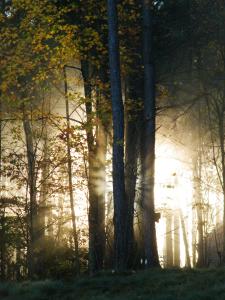 Because the air temperatures get chillier and the water of the Catawba River is still relatively warm—we end up having a great deal of foggy mornings too. It’s beautiful to get here early and watch the sun burning right through the fog. The Carolina Chickadees and Tufted Titmice don’t seem to mind at all! They forage around looking for their breakfast seeming to have no care in the world. There is always a small flock of them to be found around the office and they always bring joy to my heart to watch them.
Because the air temperatures get chillier and the water of the Catawba River is still relatively warm—we end up having a great deal of foggy mornings too. It’s beautiful to get here early and watch the sun burning right through the fog. The Carolina Chickadees and Tufted Titmice don’t seem to mind at all! They forage around looking for their breakfast seeming to have no care in the world. There is always a small flock of them to be found around the office and they always bring joy to my heart to watch them.
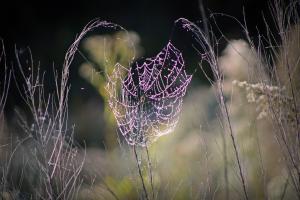 If you’ve ever been out here in the Fall—you know it’s spider web season! Some mornings the entire park looks like it has been bedazzled with jewels when the fog gets caught in their webs. A morning trek out to the grasslands will get you hundreds if not thousands of beautiful webs of orbweavers, bowl and doily spiders, and the impressive webs of the funnel web spiders.
If you’ve ever been out here in the Fall—you know it’s spider web season! Some mornings the entire park looks like it has been bedazzled with jewels when the fog gets caught in their webs. A morning trek out to the grasslands will get you hundreds if not thousands of beautiful webs of orbweavers, bowl and doily spiders, and the impressive webs of the funnel web spiders.
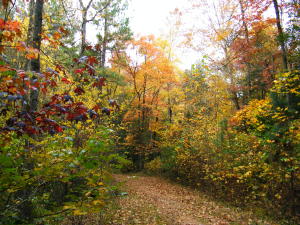 Once the leaves start changing the whole park takes on a new dimension. Every tree has its own unique color and that color can vary immensely even among the same species of tree! The Hickories glow a beautiful golden yellow while the Sweetgums mostly turn a deep burgundy which contrasts rather nicely with each other. The two species with the most variation are the Maples and Sassafrass. They can be any shade of yellow, orange, or deep red…and sometimes still green! My favorite tree, the American Beech, is slow to change but lights up the forest with its resplendent yellow to orange foliage which they keep all winter. They are one of our few tree species that do this—they won’t drop their leaves until the new leaves bud out next Spring.
Once the leaves start changing the whole park takes on a new dimension. Every tree has its own unique color and that color can vary immensely even among the same species of tree! The Hickories glow a beautiful golden yellow while the Sweetgums mostly turn a deep burgundy which contrasts rather nicely with each other. The two species with the most variation are the Maples and Sassafrass. They can be any shade of yellow, orange, or deep red…and sometimes still green! My favorite tree, the American Beech, is slow to change but lights up the forest with its resplendent yellow to orange foliage which they keep all winter. They are one of our few tree species that do this—they won’t drop their leaves until the new leaves bud out next Spring.
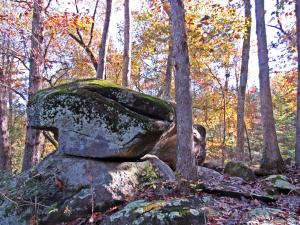 It seems everywhere you turn here there is a photo opportunity when our leaves are at peak! And our peak here in Catawba County is usually the last week of October and the first week of November. The lower parking lot along the river is filled with Dogwoods, Beeches, and Birches and usually have lots of little birds flitting around eating the berries, nuts, and catkins—as well as any little insects that are still around! Smiley Rock, as we affectionately call our boulder pile out behind the pond, is surrounded by Hickories and is a favorite “selfie” spot this time of year! Another easy and beautiful spot for photos is just up the hill from the park office. The Maples behind the bench are magnificent every year and are a good example of the range of colorations that this species can show.
It seems everywhere you turn here there is a photo opportunity when our leaves are at peak! And our peak here in Catawba County is usually the last week of October and the first week of November. The lower parking lot along the river is filled with Dogwoods, Beeches, and Birches and usually have lots of little birds flitting around eating the berries, nuts, and catkins—as well as any little insects that are still around! Smiley Rock, as we affectionately call our boulder pile out behind the pond, is surrounded by Hickories and is a favorite “selfie” spot this time of year! Another easy and beautiful spot for photos is just up the hill from the park office. The Maples behind the bench are magnificent every year and are a good example of the range of colorations that this species can show.
 I also like to do some fun things with the abundance of fall foliage that we have! Every year I try to get up under a tree and find a leaf with a small hole—and line that up with the sun. I’ve done this just about every year and have a nice collection of photographs now. I also like to pick up pretty leaves as I pass them on the trail and bring them back to the office. I get a piece of poster board and place them in different arrangements and let kids come over to the picnic table beside the office and make their own collages. I like to collect different leaves from the same tree as well and arrange them ombre style just to show how varied the colors can be even from the same tree!
I also like to do some fun things with the abundance of fall foliage that we have! Every year I try to get up under a tree and find a leaf with a small hole—and line that up with the sun. I’ve done this just about every year and have a nice collection of photographs now. I also like to pick up pretty leaves as I pass them on the trail and bring them back to the office. I get a piece of poster board and place them in different arrangements and let kids come over to the picnic table beside the office and make their own collages. I like to collect different leaves from the same tree as well and arrange them ombre style just to show how varied the colors can be even from the same tree!
 Another thing I like to do in Fall is to put pumpkins out for the wildlife. We use them as decorations for a while and then break them open so that the deer, squirrels, raccoons, and voles can enjoy them. The Deer are plentiful in the park and can be seen on just about any hike you take. They come quite often to the salt lick that we have at the bird feeders and can be found browsing on twigs and fungi out in the forest. The Squirrels are busy collecting acorns and hickory nuts to take back to their food caches and feeding their babies. Occasionally we’ll see a Chipmunk stop in to fill its cheeks up at the feeders—but they are rather uncommon here in the northern part of the county and it is always a happy surprise to find one.
Another thing I like to do in Fall is to put pumpkins out for the wildlife. We use them as decorations for a while and then break them open so that the deer, squirrels, raccoons, and voles can enjoy them. The Deer are plentiful in the park and can be seen on just about any hike you take. They come quite often to the salt lick that we have at the bird feeders and can be found browsing on twigs and fungi out in the forest. The Squirrels are busy collecting acorns and hickory nuts to take back to their food caches and feeding their babies. Occasionally we’ll see a Chipmunk stop in to fill its cheeks up at the feeders—but they are rather uncommon here in the northern part of the county and it is always a happy surprise to find one.
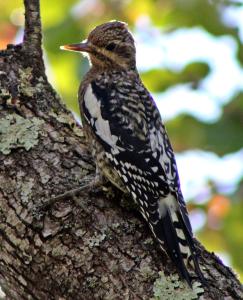 Birding at the park can be quite rewarding with the changing of the seasons. The last of the fall migrants are passing through like Cape May and Black-throated Blue Warblers—and the winter birds are returning to settle into their new territories. My favorite bird, the Pileated Woodpecker, is a year-round resident and makes their presence known by loudly drumming on hollow trees or giving its jungle-like flight call as it sails above and through the canopy. Great Horned Owls are beginning to set up their winter territories and can be heard—and sometimes seen along field edges. Our beautiful little Pine Warblers make their return to the suet feeders and add a splash of color with each visit. Winter Wrens love tangles of roots and fallen trees—so we see a lot of them here! They may be one of our smallest songbirds—but their song is one of the most melodious bubbly songs around! Yellow-bellied Sapsuckers are plentiful too. They love drilling lines of little sap wells into Maples, Hickories, and Walnut trees so that they can come by each day and have a little sip of sap. It has the added bonus of attracting insects too and many other bird species can be found utilizing these sapsucker wells.
Birding at the park can be quite rewarding with the changing of the seasons. The last of the fall migrants are passing through like Cape May and Black-throated Blue Warblers—and the winter birds are returning to settle into their new territories. My favorite bird, the Pileated Woodpecker, is a year-round resident and makes their presence known by loudly drumming on hollow trees or giving its jungle-like flight call as it sails above and through the canopy. Great Horned Owls are beginning to set up their winter territories and can be heard—and sometimes seen along field edges. Our beautiful little Pine Warblers make their return to the suet feeders and add a splash of color with each visit. Winter Wrens love tangles of roots and fallen trees—so we see a lot of them here! They may be one of our smallest songbirds—but their song is one of the most melodious bubbly songs around! Yellow-bellied Sapsuckers are plentiful too. They love drilling lines of little sap wells into Maples, Hickories, and Walnut trees so that they can come by each day and have a little sip of sap. It has the added bonus of attracting insects too and many other bird species can be found utilizing these sapsucker wells.
One of my truly favorite things to do is watch the Bald Eagles fishing for their dinner and showing them to our patrons. A lot of times they’ll just steal a fish from some other bird but because we have such a healthy population of eagles now—you can generally find at least one or two across from the observation platform or sitting up by Oxford Dam. The most I’ve ever seen here was seven—all between the dam and the platform—and all in various plumages. It takes them four years to attain their tell-tale white head and tail! Folks often ask me too about snakes. Yes. We have plenty—but you aren’t all that likely to see them. Most of what we see are Black Rat Snakes, Black Racers, Eastern Kingsnakes, and Garter Snakes like this one.
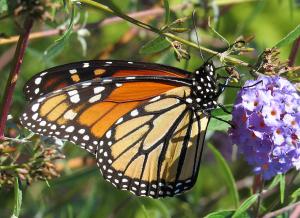 October is generally the month that our Monarch population increases too. The Goldenrods and asters are still blooming—and provides them with the fuel they need to proceed on the awesome annual migration to overwinter in the Oyamel Fir forests of the Mexican Highlands. Long-tailed Skippers are a southern species that seem to wander north this time of year. Some years we have them by the dozens and some years we don’t see any at all! They love nectaring on the butterfly bushes and the Miss Huff Lantana that we have planted around the office—so look for them the next time you visit. Other late Fall butterflies that can still be flying into November—or at least as long as there are a few asters hanging on include the Silvery Checkerspot and the Common Checkered-Skipper.
October is generally the month that our Monarch population increases too. The Goldenrods and asters are still blooming—and provides them with the fuel they need to proceed on the awesome annual migration to overwinter in the Oyamel Fir forests of the Mexican Highlands. Long-tailed Skippers are a southern species that seem to wander north this time of year. Some years we have them by the dozens and some years we don’t see any at all! They love nectaring on the butterfly bushes and the Miss Huff Lantana that we have planted around the office—so look for them the next time you visit. Other late Fall butterflies that can still be flying into November—or at least as long as there are a few asters hanging on include the Silvery Checkerspot and the Common Checkered-Skipper.
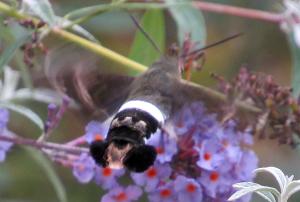 Paying attention while I’m out in the woods is something I’ve gotten pretty good at over the years. And for some reason Fall seems to be a really good time for rarities. The slightest movement draws my attention and I’ve been very lucky to have come across several really good finds! This Zebra Longwing just happened to be nectaring on some Crownbeard as I headed down the trail. There hadn’t been a sighting of this species in North Carolina since 2003—but remarkably there were 12 new county records found around the Piedmont last Fall including this one for Catawba County! (Photo 27) Another particularly exciting find was this Titan Sphinx Moth that showed up at our butterfly bush the first week of November 2018. It was—and still is—the first and only record of this species for the state!
Paying attention while I’m out in the woods is something I’ve gotten pretty good at over the years. And for some reason Fall seems to be a really good time for rarities. The slightest movement draws my attention and I’ve been very lucky to have come across several really good finds! This Zebra Longwing just happened to be nectaring on some Crownbeard as I headed down the trail. There hadn’t been a sighting of this species in North Carolina since 2003—but remarkably there were 12 new county records found around the Piedmont last Fall including this one for Catawba County! (Photo 27) Another particularly exciting find was this Titan Sphinx Moth that showed up at our butterfly bush the first week of November 2018. It was—and still is—the first and only record of this species for the state!
I hope I’ve given you some things that you want to see over the next month or so! There is always so much to see and experience at our county parks. We value our natural heritage and pride ourselves in making your experience in and with Nature a rewarding one. We are always available to answer your questions or to make suggestions on which trails would have something you may be interested in seeing—so give us a call at the office (828) 256-9157 or just stop by in person.
